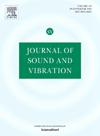Wave propagation modelling approach for improved assessment of the acoustic field in closed test section wind tunnels
IF 4.3
2区 工程技术
Q1 ACOUSTICS
引用次数: 0
Abstract
Sound propagation in closed test section wind tunnels suffers from reflections and diffraction, which compromise acoustic measurements. In this article, it is proved possible to improve the post-processing of phased-array microphone measurements by using an approach based on the combination of numerical acoustic simulations and beamforming. A Finite Element Method solver for the Helmholtz equation is used to model the acoustic response of the experimental facility. The simulations are compared with acoustic experiments performed at TU Delft’s Low Turbulence Tunnel, using both fully reflective (baseline) and lined test sections. The solver accurately predicts the acoustic propagation from a monopole sound source at the centre of the test section to the microphones in the phased-array, for frequencies in the range . It is shown that a (lower fidelity) geometric modelling method is unable to precisely predict the acoustic response of the Low Turbulence Tunnel at these frequencies, due to strong acoustic diffraction. The numerical results are used to implement corrections to the post-processing of experimental data. A corrected version of the Source Power Integration method is able to increase the accuracy of the source’s noise levels calculation, based on a single numerical simulation with the source at the same location as in the experiment. A Green’s function correction increases the beamforming resolution and the source’s noise levels estimation accuracy from the beamforming maps, without a priori knowledge of the source’s location. Both corrections perform well at processing flow-on acoustic measurements, and the Green’s function correction shows an additional benefit. The improvement in beamforming spatial resolution leads to an increase of the signal to noise ratio.
求助全文
约1分钟内获得全文
求助全文
来源期刊

Journal of Sound and Vibration
工程技术-工程:机械
CiteScore
9.10
自引率
10.60%
发文量
551
审稿时长
69 days
期刊介绍:
The Journal of Sound and Vibration (JSV) is an independent journal devoted to the prompt publication of original papers, both theoretical and experimental, that provide new information on any aspect of sound or vibration. There is an emphasis on fundamental work that has potential for practical application.
JSV was founded and operates on the premise that the subject of sound and vibration requires a journal that publishes papers of a high technical standard across the various subdisciplines, thus facilitating awareness of techniques and discoveries in one area that may be applicable in others.
 求助内容:
求助内容: 应助结果提醒方式:
应助结果提醒方式:


